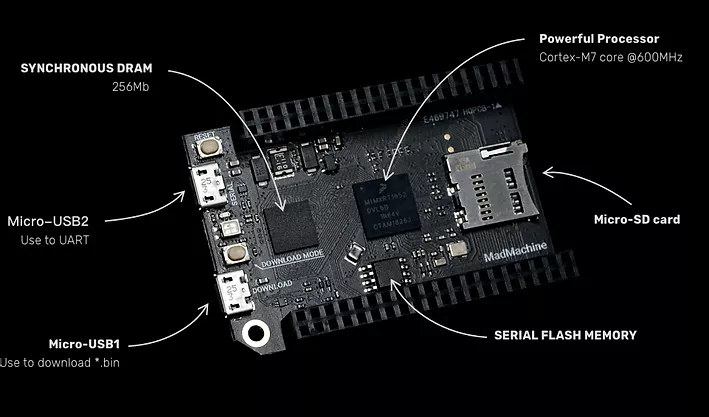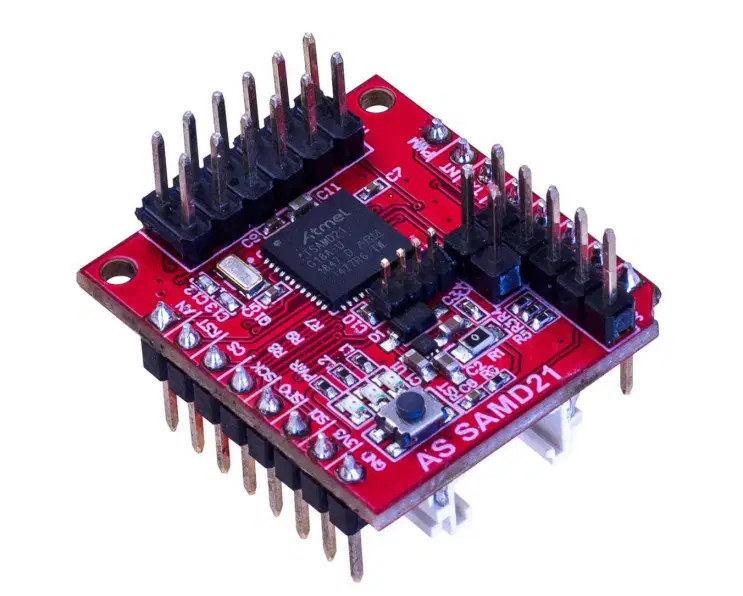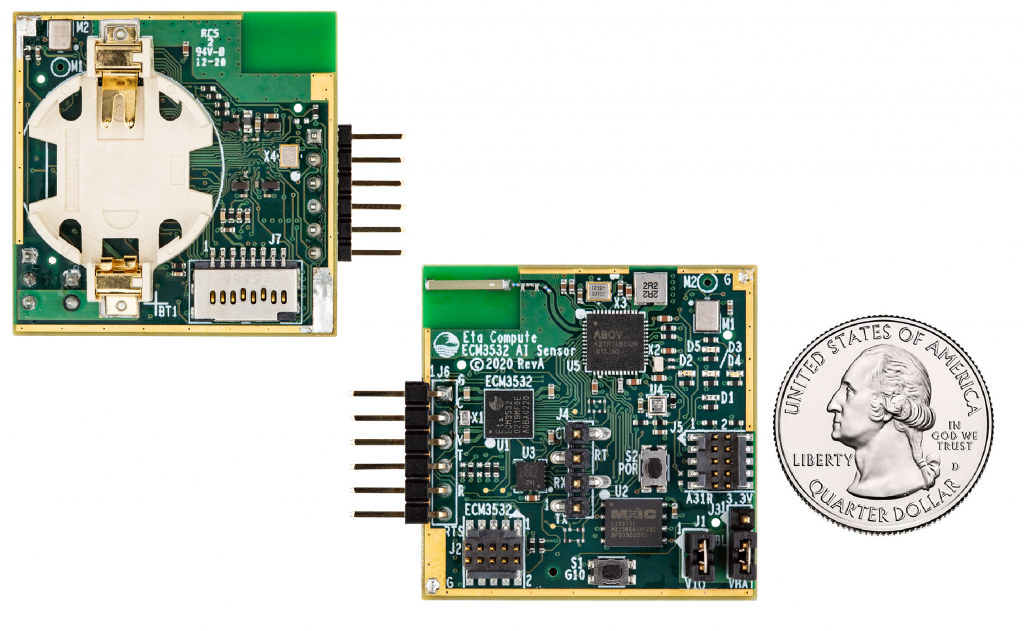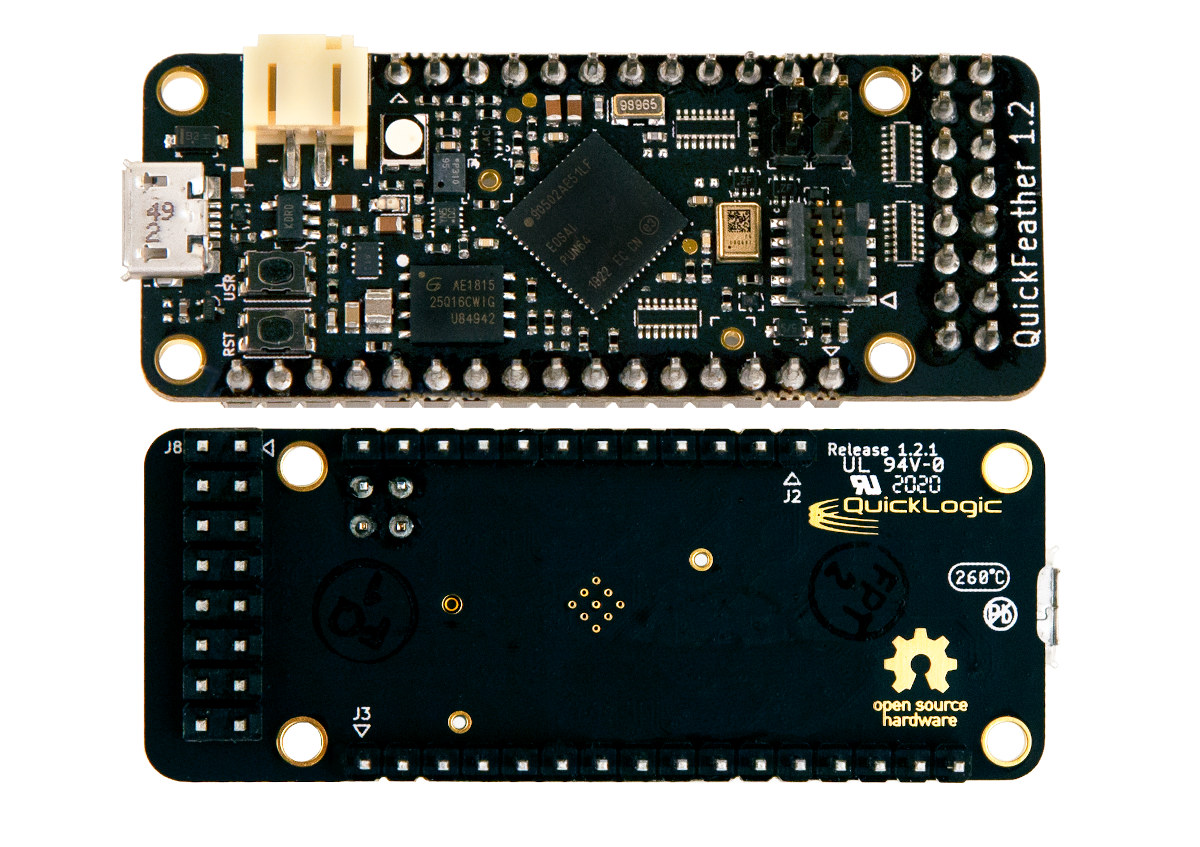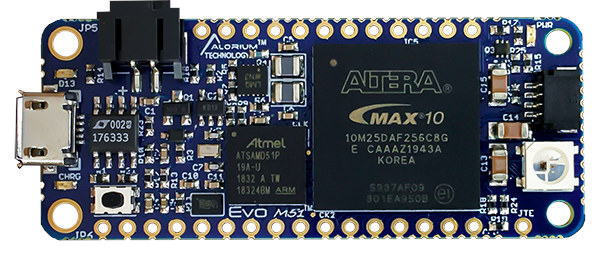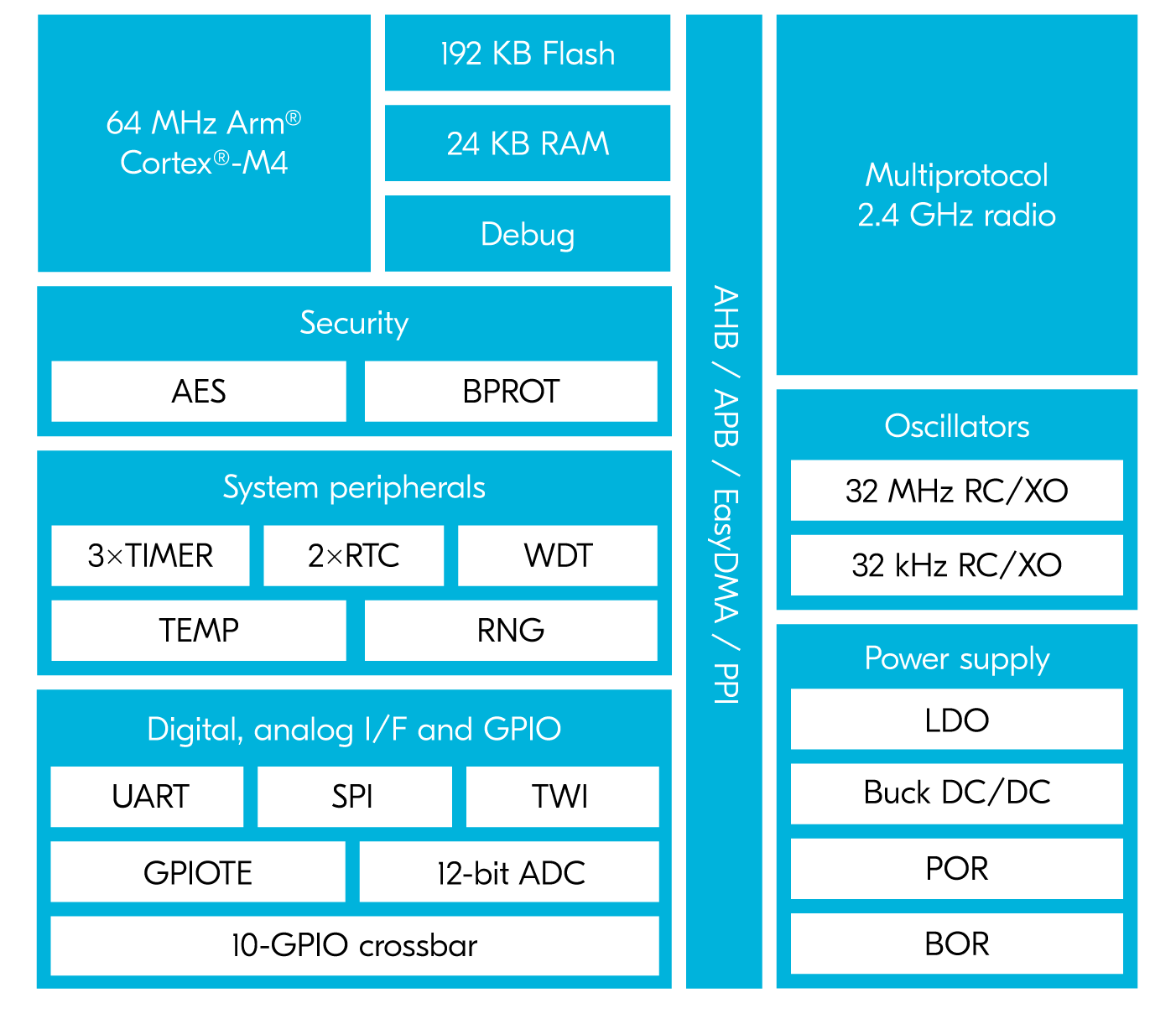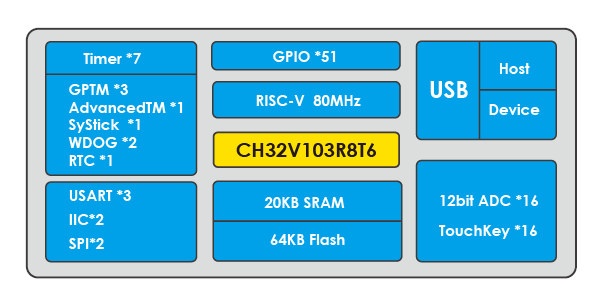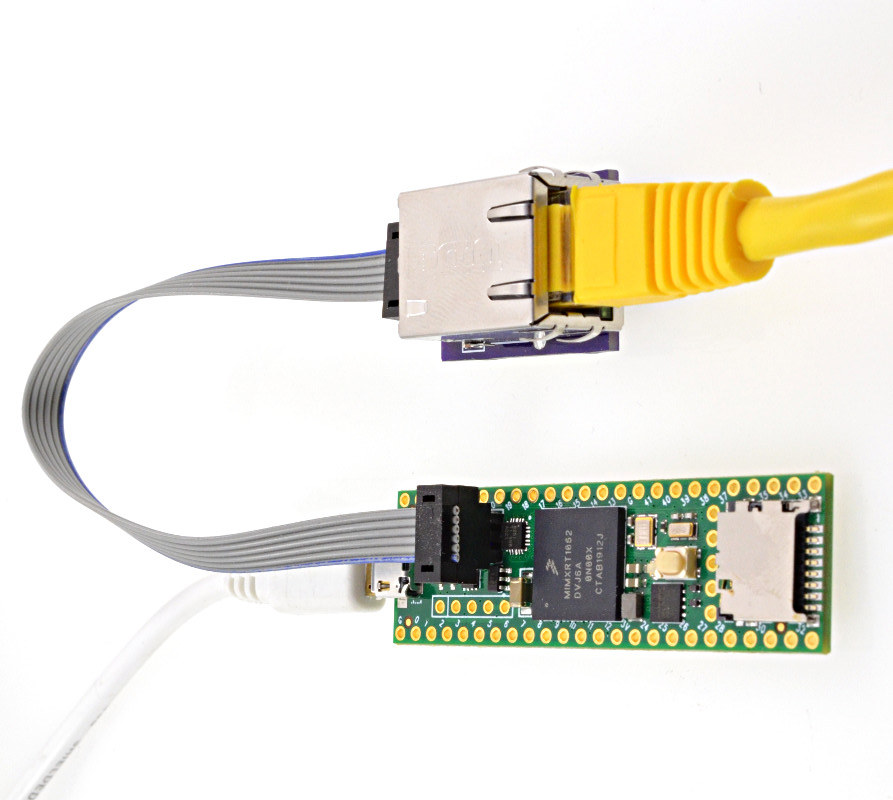Swift programming language has been developed by Apple for iOS, iPadOS, macOS, watchOS, tvOS, and Linux. The programming language works with Apple’s Cocoa and Cocoa Touch frameworks, as well as existing Objective-C code written for Apple products. MadMachine has now created an Arm Cortex-M7 development board, named SwiftIO, specifically designed for Swift programming language through MadMachine IDE and SwiftIO framework. SwiftIO hardware specifications: SoC – NXP i.MX RT1052 Arm Cortex-M7 Crossover Processor @ 600MHz System Memory – 32 MB SRAM Storage – MicroSD card slot supporting standard and high capacity SD cards USB – 1x Micro USB connector for power, 1x Micro USB connector for serial communication Expansion – 2x 46 GPIO headers with 12x 12-bit analog to digital (ADC) converters, 4x UART, 2x CAN, 2x IIC, 2x SPI, 14x PWM Misc – On-board RGB LED, download and reset buttons Power Supply – 5V via Micro USB port Dimensions – […]
SAMD21 Lite is a Stamp-sized, MikroBus Compatible Cortex-M0+ MCU Board
If you’re a fan of tiny microcontroller boards, you’ll be pleased with BOKRA SAMD21 Lite board powered by Microchip SAMD21 Arm Cortex-M0+ MCU, exposing I/Os in a way compatible with MikroBus socket, and adding a Grove connector for good measure. SAMD21 Lite board specifications: MCU – Microchip ATSAMD21G18A Arm Cortex-M0+ microcontroller @ 48 MHz with 256KB flash memory, 32KB RAM Expansion I/Os MicroBus socket with GPIO, SPI, I2C, USART, PWM, DAC, +5V, +3.3V, GND I2C Grove connector 10-pin I/O header with GPIO, USB 2.0, VIN, GND Misc – Reset button, red power LED, 2x user LED (yellow/green), J1/J2 jumper to enable/disable I2C pull-ups Debugging – 4-pin SWD header Power Supply 5V input via VIN MIC5528500 voltage regulator Output current – 500 mA Dimensions -28.6 x 25.4 mm Despite its tiny size, SAMD21 Lite exposes all expect five I/Os from the microcontroller. The Microbus headers and the I2C Grove connector allow […]
ECM3532 AI Sensor Board Features Cortex-M3 MCU & 16-bit DSP “TENSAI” SoC for TinyML Applications
Eta Compute ECM3532 is a system-on-chip (SoC) with a Cortex-M3 microcontroller clocked at up to 100 Mhz, and NXP CoolFlux 16-bit DSP designed for machine learning on embedded devices, aka TinyML, and part of the company’s TENSAI platform. The chip is also integrated into the ECM3532 AI sensor board featuring two MEMS microphones, a pressure & temperature sensor, and a 6-axis motion sensor (accel/gyro) all powered by a CR2032 coin-cell battery. ECM3532 AI sensor board specifications: SoC – ECM3532 neural sensor processor with Arm Cortex-M3 core @ up to 100 MHz (< 5μA/MHz run mode) combines with 512KB embedded FLASH, 256KB SRAM, and 8KB BootROM + secure bootloader, and NXP CoolFlux 16-bit DSP @ up to 100 MHz with 32KB program memory, 64KB data memory. See the product brief for details. Storage – 64Mbit serial Flash for datalogging Connectivity – Bluetooth 4.2 LE via ABOV Semiconductor A31R118 and PCB antenna […]
QuickFeather Board is Powered by QuickLogic EOS S3 Cortex-M4F MCU with embedded FPGA (Crowdfunding)
Yesterday, I wrote about what I felt what a pretty unique board: Evo M51 board following Adafruit Feather form factor, and equipped with an Atmel SAMD51 Cortex-M4F MCU and an Intel MAX 10 FPGA. But less than 24 hours later, I’ve come across another Adafruit Feather-sized Cortex-M4F board with FPGA fabric. But instead of using a two-chip solution, QuickLogic QuickFeather board leverages the company’s EOS S3 SoC with a low-power Cortex-M4F core and embedded FPGA fabric. QuickFeather board QuickFeather specifications: SoC – QuickLogic EOS S3 with Arm Cortex-M4F Microcontroller @ up to 80 MHz and 512 Kb SRAM, plus an embedded FPGA (eFPGA) with 2400 effective logic cells and 64Kb RAM Storage – 16Mbit SPI NOR flash USB – Micro USB port with data signals tied to eFPGA programmable logic Sensors – Accelerometer, pressure sensor, built-in PDM microphone Expansion I/Os – Breadboard-compatible 0.1″ (2.54 mm) pitch headers including 20 Feather-defined […]
Feather-Sized Evo M51 Board Combines Atmel SAMD51 MCU with Intel MAX 10 FPGA
Arduino unveiled its first FPGA board around two years ago with MKR Vidor 4000 combining an Intel Cyclone FPGA with Microchip SAMD21 Cortex-M0+ MCU in a form factor similar to Arduino Zero. But in case you are looking for an even smaller Arduino compatible FPGA board, Alorium Technology’s Evo M51 might be exactly what you are after. The Adafruit Feather-sized board is equipped with an Atmel SAMD51 Arm Cortex-M4F microcontroller coupled with an Intel MAX 10 FPGA. Evo M51 specifications: MCU – Microchip (Atmel) SAMD51 Arm Cortex-M4F microcontroller clocked at 120 MHz with 512KB flash, 192 KB SRAM FPGA – Intel MAX 10 (10M25) FPGA with 25K LEs, 675Kbit block memory Storage – 2MB external flash USB – 1x micro USB port for power and programming I/O Digital 55x Total Digital I/O – 21x through-hole/castellated vias, 34x additional castellated-only 6x digital pins shared with analog pins 3.3V Inputs, 3.3V Outputs […]
nRF52805 Tiny Bluetooth 5.2 SoC is Optimized for Small Two-layer PCB Designs
Nordic Semi has just added a new member to its nRF52 Bluetooth 5 wireless SoC family with nRF52805 offered in a tiny WLCSP package measuring 2.48×2.46 mm and optimized for cost-effective 2-layer PCB designs. nRF52805 key features and specifications: MCU Core – Arm Cortex-M4 @ 64 MHz Storage & Memory – 192 KB Flash, 24 KB RAM Wireless Bluetooth Low Energy and 2.4 GHz proprietary protocols. High bitrate – 2 Mbps, 1 Mbps +4 dBm TX power -97 dBm RX sensitivity (1 Mbps Bluetooth LE) Integrated balun with single-ended output I/Os – UART, SPI, TWI, 2-channel 12-bit ADC Security 128-bit AES Power Consumption 7 mA in TX (4 dBm) 4.6 mA in TX (0 dBm) 4.6 mA in RX (1 Mbps) 0.3 μA in System OFF 1.1 μA in System ON with 24 KB RAM retained and RTC running Supply Voltage – 3.6V max Package – 2.48×2.46 mm WLCSP Note […]
WCH CH32V103 General-Purpose RISC-V MCU Offers an Alternative to GD32V RISC-V Microcontroller
Last year, WCH introduced their first RISC-V MCU with CH572 Bluetooth LE microcontroller which came with 10KB SRAM and a not so convenient 96KB OTP flash. But I’ve just been informed the company has introduced their first general-purpose RISC-V MCU family with several CH32V103 microcontrollers featuring up to 64KB Flash and 20KB SRAM, and all sort of peripherals you’d expect from a general-purpose MCU. WCH CH32V103 key features and specifications: CPU Core – 32-bit RISC-V (RV32IMAC) core @ up to 72/80 MHz called ” RISC-V3A” Memory – 10KB or 20KB SRAM Storage – 32KB or 64KB flash Peripherals 1x USB 2.0 Full Speed Host/Device Up to 2x SPI (master/slave), up to 2x I2C, up to 3x USART Up to 16x 12-bit ADC/touch key 37x or 51x GPIOs Up to 3x general-purpose timers, 1x advanced timer, 2x watchdog timers, 1x Systick Supply Voltage – 2.7 to 5.5V Package – LQFP48, QFN48 […]
Teensy 4.1 Board Gets Longer for Ethernet, MicroSD Slot, and More GPIOs
What comes after Teensy 4.0? Teensy 4.1. The new version of the Arduino compatible board is powered by the same NXP i.MX RT1062 Cortex-M7 crossover processor clocked at 600 MHz, but about doubling in length in order to add a 10/100 Mbit Ethernet PHY, a MicroSD card slot, and offer more I/Os. Teensy 4.1 also increases flash memory to 8 MB (vs 2 MB for Teensy 4.0), and the USB hot-plugging power management circuitry needed to plug a USB device via a USB host cable. Teensy 4.1 specifications: SoC – NXP i.MX RT1062 Arm Cortex-M7 processor at 600 MHz with 1024KB RAM (512KB is tightly coupled), Storage – 8 MB serial flash (64KB reserved for recovery & EEPROM emulation), MicroSD Socket, footprints for 2x extra QSPI chips such as flash or 8MB PSRAM chip USB – 1x micro USB port for power and programming Networking – 6-pin Ethernet header via […]


